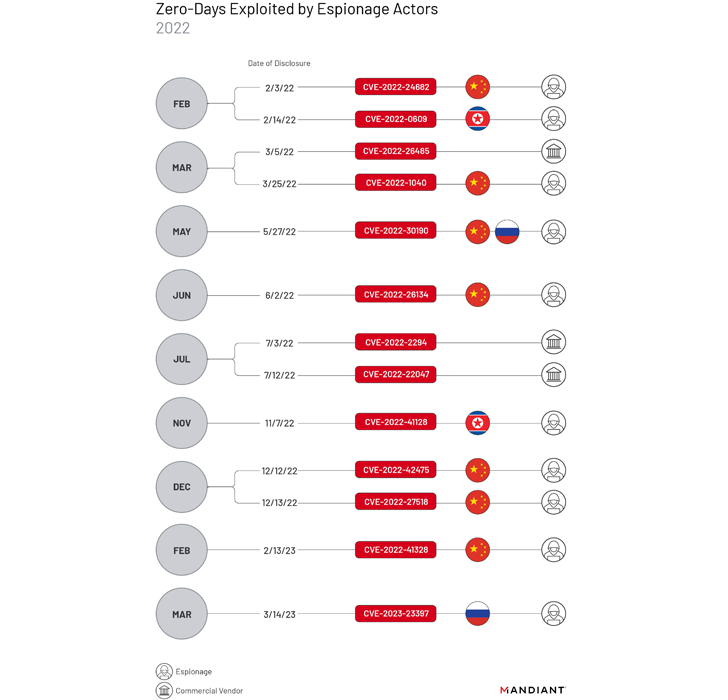As many as 55 zero-day vulnerabilities were exploited in the wild in 2022, with most of the flaws discovered in software from Microsoft, Google, and Apple.
While this figure represents a decrease from the year before, when a staggering 81 zero-days were weaponized, it still represents a significant uptick in recent years of threat actors leveraging unknown security flaws to their advantage.
The findings come from threat intelligence firm Mandiant, which noted that desktop operating systems (19), web browsers (11), IT and network management products (10), and mobile operating systems (six) accounted for the most exploited product types.
Of the 55 zero-day bugs, 13 are estimated to have been abused by cyber espionage groups, with four others exploited by financially motivated threat actors for ransomware-related operations. Commercial spyware vendors were linked to the exploitation of three zero-days.
Among state-sponsored groups, those attributed to China have emerged as the most prolific, exploiting seven zero-days – CVE-2022-24682, CVE-2022-1040, CVE-2022-30190, CVE-2022-26134, CVE-2022-42475, CVE-2022-27518, and CVE-2022-41328 – during the year.
Much of the exploitation has focused on vulnerabilities in edge network devices such as firewalls for obtaining initial access. Various China-nexus clusters have also been spotted leveraging a flaw in Microsoft Diagnostics Tool (aka Follina) as part of disparate campaigns.
“Multiple separate campaigns may indicate that the zero-day was distributed to multiple suspected Chinese espionage clusters via a digital quartermaster,” Mandiant said, adding it points to the “existence of a shared development and logistics infrastructure and possibly a centralized coordinating entity.”

North Korean and Russian threat actors, on the other hand, have been linked to the exploitation of two zero-days each. This includes CVE-2022-0609, CVE-2022-41128, CVE-2022-30190, and CVE-2023-23397.
The disclosure comes as threat actors are also getting better at turning newly disclosed vulnerabilities into powerful exploits for breaching a wide range of targets across the world.
“While the discovery of zero-day vulnerabilities is a resource-intensive endeavor and successful exploitation is not guaranteed, the total number of vulnerabilities disclosed and exploited has continued to grow, the types of targeted software, including Internet of Things (IoT) devices and cloud solutions, continue to evolve, and the variety of actors exploiting them has expanded,” Mandiant said.
Discover the Hidden Dangers of Third-Party SaaS Apps
Are you aware of the risks associated with third-party app access to your company’s SaaS apps? Join our webinar to learn about the types of permissions being granted and how to minimize risk.
RESERVE YOUR SEAT
The Mandiant report also follows a warning from Microsoft’s Digital Threat Analysis Center about Russia’s persistent kinetic and cyber targeting as the war in Ukraine continues into the second year.
The tech giant said since January 2023 it has observed “Russian cyber threat activity adjusting to boost destructive and intelligence gathering capacity on Ukraine and its partners’ civilian and military assets.”

It further warned of a possible “renewed destructive campaign” mounted by the nation-state group known as Sandworm (aka Iridium) on organizations located in Ukraine and elsewhere.
What’s more, Moscow-backed hackers have deployed at least two ransomware and nine wiper families against over 100 Ukrainian entities. No less than 17 European countries have been targeted in espionage campaigns between January and mid-February 2023, and 74 countries have been targeted since the start of the war.
Other key traits associated with Russian threat activity include the use of ransomware as weapons of cyber sabotage, gaining initial access through diverse methods, and leveraging real and pseudo hacktivist groups to expand the reach of Moscow’s cyber presence.
